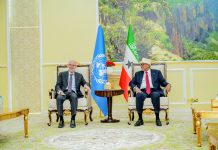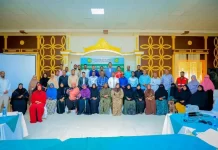Since its self-declaration of independence in 1991, Somaliland has – against many odds – established a system of democratic governance and embarked upon an ambitious development agenda including the development of a National Development Plan (NDP 2012-16).
To help strengthen planning and budgeting processes, and improve the allocation of scarce resources, the World Bank has undertaken several pieces of analytical work to help provide the first GDP and poverty estimates for Somaliland. These will be discussed at the Somaliland Economic Conference on Growth & Unemployment, Poverty & Inflation and Budget Policy hosted by the Ministry for National Planning and Development and the World Bank in Hargeisa on 29 January 2014.
- GDP and Unemployment
Based on initial GDP analysis -to be updated as data improves and further data becomes available- Somaliland’s GDP for 2012 is estimated to have been $1.4 billion (current US$ prices), with GDP per capita estimated at $347. This would be the fourth lowest in the world, ahead of Malawi, the Democratic Republic of the Congo and Burundi.
Almost 30% of GDP is derived from the livestock industry followed by 20% from wholesale and retail trade (including the informal sector); 8% from crops and 6% from real estate activities. In 2012, Somaliland’s trade deficit was approximately $496 million, which was financed through a combination of remittances and external aid. Somaliland has very low levels of investment, ranked approximately 180thin the World for gross fixed capital formation as a percentage of GDP. Furthermore, Somaliland has very low employment-to-population ratios, with 28% for males and 17% for females (15-24-year-olds in Borama, Hargeisa, and Burao.
- 2. Poverty and Inequality in Somaliland
Somaliland is a low-income country with Gross Domestic Product per capita of USD348 (not adjusted for Purchasing Power Parity) in 2013. By income level, it ranks 4th lowest in the World, ahead of Burundi, DR Congo, and Malawi.
Initial estimates suggest that poverty in urban areas of Somaliland is 29%, similar to Ethiopia (26%) but that rural poverty at 38% in Somaliland is higher. Although urban households are better off, inequality is high and similar to levels recorded in the 2005 household survey in Kenya.
Access to health services in urban areas compares well to other countries in the region, but in rural areas most births are at home without a skilled attendant. Mothers are more likely to die giving birth, and babies more likely to die before their first birthday, in Somaliland than in neighboring Ethiopia or Djibouti.
Only about half of 6-13 years old go to primary school in Somaliland, in stark contrast to 87% in neighboring Ethiopia. As current school enrollment is much lower in Somaliland than in all countries in the region, Somaliland could well have poor comparative literacy rates in the future.
In the absence of PPP estimates for Somaliland it is difficult to compare poverty rates with other countries, but a comparison of similarly constructed numbers for regional comparators suggests urban poverty is similar in Somaliland to urban poverty rates in South Sudan and Ethiopia, but rural poverty is much higher than poverty in rural Ethiopia, although lower than poverty in rural Sudan. Poverty is typically compared across countries using a poverty line of USD 1.25 in 2005 Purchasing Power Parity (PPP); no PPP estimates exist for Somaliland making it difficult to compare the level of poverty in Somaliland to other countries in the region. However, the urban poverty rate in Somaliland is similar to the 26% urban poverty rate recorded in Ethiopia in 2010/11 using a similar methodology and the 24.4% poverty rate recorded in South Sudan in 2011. Rural poverty in Somaliland is higher as compared to the poverty rate of 30% in rural Ethiopia but lower than the rate of 55.4% in South Sudan. Recent poverty estimates for Djibouti and Kenya are not available.
Table 1: Poverty headcount and poverty gap (national poverty line, regional comparison)
| Indicator | Somaliland | Ethiopia | South Sudan
|
||||||||||
| Urban | Rural | Urban | Rural | Urban | Rural
|
||||||||
| Headcount | 28.7% | 38.1% | 25.7% | 30.4% | 24.4% | 55.4%
|
|||||||
| Poverty Gap | 8.4% | 12.8% | 6.9% | 8.0% | 8.8% | 26.5%
|
|||||||
| Poverty Severity | 3.6% | 5.8% | 2.7% | 3.2% | 4.6% | 16.1% | |||||||
Somaliland has a high prevalence of undernutrition
Somaliland has a high prevalence of undernutrition. If we assume 2,100 kilocalories/person/day as a cut-off point to mark the threshold of undernutrition, the incidence of undernutrition is larger in rural areas (57.2%) than in urban areas (41.5%), Figure 3. Table 3shows the incidence of undernutrition (percentage of people with calorie intake lower than 2,100 kcal/person/day) as well as the percentage of individuals with a diet poor of proteins (less than 50 grams/person/day). This is interpreted as a measure of malnutrition.
|
Table 3: Incidence of undernutrition and malnutrition
Undernutrition |
Malnutrition |
||
| Urban | 41.5 | 44 | |
| s.e. | (2.20) | (2.20)
|
|
| Rural | 57.2 | 68.2 | |
| s.e. | (3.00) | (3.00)
|
|
Budget Policy
Tax revenue as a percentage of GDP in Somaliland (approximately 7% in 2012) is less than half the sub-saharan African average. Historical low levels of domestic revenue have only been able to sustain core Government functions and maintain peace and stability. The lack of investment in social services, has taken a toll on human development. The Somaliland authorities have taken recent, commendable, strides in strengthening budgeting and planning and enhancing revenue, and the Budget Policy Committee now ring-fences 10-13% of the growing budget for investment activities. Establishment of the Somaliland Development Fund (SDF) has also enabled Government to exercise greater control over external resources.
Recommendations
- Creating Good Jobs
both in the United States and abroad, is a great way to reduce poverty. When people have jobs, they have income, and when people have income, they can more easily get themselves out of poverty. The U.N. says that “unemployment and underemployment lies at the core of poverty. For the poor, labor is often the only asset they can use to improve their well-being.”
2. Educating Women
The education of girls and women impacts the rest of the societies in which these girls and women live. A woman’s degree of education is linked to the age at which she marries and has children, to her health and diseases, to her economic opportunities, to her social standing, and to her general future wellbeing. Educating girls and women can reduce poverty in developing nations, as well as in the United States.
3. Raising Wages
The United States hasn’t raised the federal minimum wage since 2007. Because of this, right now, “A full-time worker with two children earning the minimum wage will still raise his or her family in poverty.” And this is an issue in almost every other country, especially in developing nations. Raising the minimum wages could potentially increase the health and well-being of millions.
4. Microfinancing
Microfinance is defined as the “supply of loans, savings, and other basic financial services to the poor.” Right now, only about 10 percent of the global population has access to traditional banking, according to the Gates Foundation. However, using microfinance, people who are unemployed or who have a low income could get small loans to help them become self-sufficient. An organization called Kiva has provided more than $329 million to 786,000 borrowers, with a repayment rate of 98.97%. Microfinance is a promising way to alleviate poverty.
5. Gender Equality
As the U.N. Development Programme says, “when women have equal access to education, and go on to participate fully in business and economic decision-making, they are a key driving force against poverty.” Not only this, but better gender equality raises household incomes and “translates into better prospects and greater well-being of children,” which is a smart way reduce the poverty for future generations as well as our own.
6. Transparency in Government Spending
Creating transparency in government spending of money can help reduce corruption in governments. When governments are accountable to their citizens for their action, or inaction, in different areas of the federal budget, the citizens will be able to accurately assess how well their leaders are leading their country. Also, it allows citizens to see if money is being taken away from poverty-reduction plans and into the pockets of their leaders, which could be a cause of a stagnant economy or job market.
7. Access to Healthcare
The President of the World Bank, Jim Yong Kim, says that he believes “universal health insurance coverage in all countries can help achieve a goal of ending extreme poverty by 2030.” He says that because about 100 million people are pushed into extreme poverty every year by having to spend money on health issues, and that because health issues push about another 150 million into severe financial hardship, universal health insurance could greatly relieve poverty, globally.
8. Access to Clean Water and Sanitation
The World Bank says that access to clean water and sanitation is “one of the most cost-effective development interventions, and is critical for reducing poverty.” The reasons for this are that women can use the time that they would have spent fetching water to work and produce more, agricultural production could increase, and the costs of services and goods could go down. Not only that, but because diseases caused by unsafe drinking water and poor sanitation cause “the most significant child health problems worldwide,” having access to clean water could significantly lower the healthcare burden for many of these many children.
9. Nutrition, Especially in Infants
Adequate nutrition is an incredibly important indicator of a person’s ability to get out of poverty, later in life. Those who are malnourished from the time of conception to 24 months, postpartum “have a higher risk of lifelong physical and mental disability.” Because of this, they are “often trapped in poverty,” and are not able to make the full contribution to the “social and economic development of their households and communities, as adults.”
References
Alkire, S. and Santos, M.E. (2013) “Measuring Acute Poverty in the Developing World: Robustness and Scope of the Multidimensional Poverty Index.” Oxford Poverty & Human Development Initiative Working Paper No. 59.
Amendola, Veccchi, and Hill (2014), Poverty Measurement in Somaliland, World Bank PREM
Deaton A. and S. Zaidi (2002), “Guidelines for Constructing Consumption Aggregates for Welfare Analysis.” Living Standards Measurement Study Working Paper n. 135. The World Bank, Washington, DC.
Ferreira, F.H.G. and Lugo, M.A. (2012) “Multidimensional Poverty Analysis: Looking for a Middle Ground.” Policy Research Working Paper 5964.
Ethiopia Ministry of Finance, Planning and Economic Development. 2013. Poverty and Growth in Ethiopia, 1995/96-2010/11.
Somaliland Ministry of Planning and National Development and UNICEF. (2013 ). MICS. UNICEF.
UNDP. (2006/07). Community Census for Poverty Assessment and Mapping . UNDP.
UNICEF. (2006). MICS Somaliland. UNICEF.
World Bank, 2011. A Poverty Profile for the Southern States of Sudan. Report 69521
– Taylor Prinsen
(By: Abdirahman Khadar Abdihaad “Ortega Haad”)































